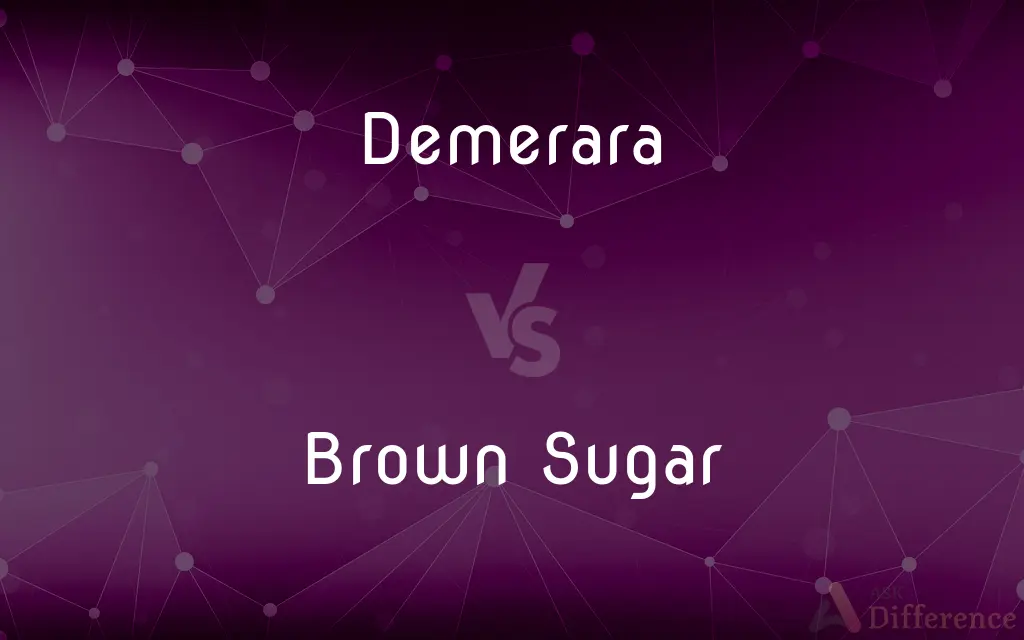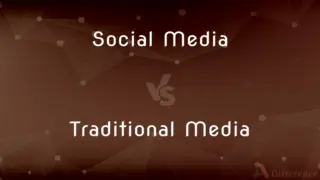Demerara vs. Brown Sugar — What's the Difference?
Edited by Tayyaba Rehman — By Fiza Rafique — Published on November 20, 2023
Demerara is a raw, coarse-textured sugar with large golden crystals, while brown sugar is refined white sugar combined with molasses, giving it a moist texture and caramel flavor.

Difference Between Demerara and Brown Sugar
Table of Contents
ADVERTISEMENT
Key Differences
Demerara and brown sugar both originate from sugarcane, but their processing methods and attributes make them stand apart. Demerara sugar is derived from the initial pressing of sugarcane, which then undergoes minimal processing, retaining its natural caramel flavor. Brown sugar, conversely, starts as white sugar and gains its color and flavor from the reintroduction of molasses.
In terms of appearance, Demerara showcases large, golden, crunchy crystals. Its texture is somewhat dry compared to the moist, clumpy nature of brown sugar. Both sugars are often used in baking and cooking, but their unique characteristics can affect the outcome of a dish. For instance, Demerara, with its large granules, offers a delightful crunch in topping applications.
The flavor profile of Demerara is subtle, with hints of toffee and caramel, while brown sugar delivers a deeper, molasses-forward taste. When considering sweetness, both sugars differ slightly. While Demerara provides a mild sweetness, brown sugar's richness stems from the added molasses.
From a geographical standpoint, Demerara gets its name from the Demerara region in Guyana, where it was originally produced. Brown sugar, however, doesn't have a specific region of origin, and its name is solely descriptive of its color and content.
Comparison Chart
Origin
Initial pressing of sugarcane
Refined white sugar with added molasses
ADVERTISEMENT
Texture
Coarse, large crystals
Moist, clumpy
Flavor
Subtle hints of toffee and caramel
Deep molasses flavor
Sweetness Level
Mild sweetness
Rich sweetness due to molasses
Geographical Naming
Named after the Demerara region in Guyana
Descriptive name based on color and content
Compare with Definitions
Demerara
A raw sugar with large, golden crystals.
I sprinkled Demerara on my oatmeal for added crunch.
Brown Sugar
Sugar known for its moist, clumpy texture.
The brown sugar clung together in the bag, requiring a break-up.
Demerara
Sugar derived from the first pressing of sugarcane.
For a natural sweetness, she chose Demerara over other sugars.
Brown Sugar
A sweetener often used in baking and sauces.
Brown sugar caramelized beautifully in the dessert recipe.
Demerara
Sugar named after its origin in Guyana.
Authentic Demerara traces its roots back to Guyana.
Brown Sugar
Sugarcane-derived sugar with a distinctive caramel hue.
The warm hue of brown sugar made the dish visually appealing.
Demerara
Coarse sugar often used as a topping.
The muffins were finished with a sprinkle of Demerara.
Brown Sugar
A refined sugar with added molasses.
She used brown sugar to give the sauce a rich flavor.
Demerara
A less refined sugar with hints of caramel.
Demerara's toffee notes enhanced the flavor of the cookie.
Brown Sugar
Sugar with a deep molasses taste.
The brown sugar added a depth of flavor to the cookies.
Demerara
A light brown raw cane sugar from Guyana
Demerara
A river in northern Guyana that flows northward into the Atlantic
Demerara
A former Dutch colony in South America; now a part of Guyana
Demerara
Dark rum from Guyana
Demerara
Light brown cane sugar; originally from Guyana
Common Curiosities
Can I substitute Demerara for brown sugar in recipes?
Yes, but it may alter the texture and flavor slightly.
Which is sweeter, Demerara or brown sugar?
Brown sugar, due to the added molasses, tends to be richer in sweetness.
Why does brown sugar clump together?
The moisture from the molasses in brown sugar causes it to clump.
Why is brown sugar moist?
The added molasses gives brown sugar its moist texture.
Can I use Demerara for caramel sauce?
Yes, but it will have a distinct flavor and texture compared to brown sugar.
Can brown sugar harden over time?
Yes, exposure to air can cause brown sugar to harden. Store it in an airtight container.
What gives Demerara its golden color?
It retains more of the natural sugarcane color due to minimal processing.
What is the primary difference between Demerara and brown sugar?
Demerara is a raw sugar with large crystals, while brown sugar is refined white sugar with added molasses.
Is Demerara healthier than brown sugar?
Both are forms of sugar, but Demerara undergoes less processing. Health impact depends on overall diet.
Which sugar is better for a crunchy cookie topping?
Demerara, with its large granules, offers a delightful crunch.
Why does brown sugar dissolve slower than regular sugar?
The moisture from the molasses affects its dissolution rate.
Can I make my own brown sugar?
Yes, by mixing molasses with white sugar until you achieve the desired color and consistency.
Is Demerara sugar the same as Turbinado sugar?
They're similar but may differ in crystal size and origin.
Are there different types of brown sugar?
Yes, there's light and dark brown sugar, determined by the molasses content.
Is all Demerara produced in Guyana?
While it originated there, Demerara is now produced in other regions as well.
Share Your Discovery

Previous Comparison
Circuit Court vs. District Court
Next Comparison
Social Media vs. Traditional MediaAuthor Spotlight
Written by
Fiza RafiqueFiza Rafique is a skilled content writer at AskDifference.com, where she meticulously refines and enhances written pieces. Drawing from her vast editorial expertise, Fiza ensures clarity, accuracy, and precision in every article. Passionate about language, she continually seeks to elevate the quality of content for readers worldwide.
Edited by
Tayyaba RehmanTayyaba Rehman is a distinguished writer, currently serving as a primary contributor to askdifference.com. As a researcher in semantics and etymology, Tayyaba's passion for the complexity of languages and their distinctions has found a perfect home on the platform. Tayyaba delves into the intricacies of language, distinguishing between commonly confused words and phrases, thereby providing clarity for readers worldwide.













































